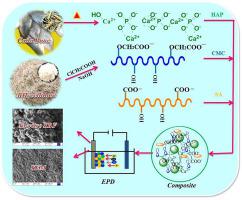当前位置:
X-MOL 学术
›
Mater. Chem. Phys.
›
论文详情
Our official English website, www.x-mol.net, welcomes your feedback! (Note: you will need to create a separate account there.)
Physicochemical and biological behaviour of biogenic derived hydroxyapatite and carboxymethyl cellulose/sodium alginate biocomposite coating on Ti6Al4V alloy for biomedical applications
Materials Chemistry and Physics ( IF 4.6 ) Pub Date : 2020-11-01 , DOI: 10.1016/j.matchemphys.2020.123455 S. Sridevi , S. Sutha , L. Kavitha , D. Gopi
Materials Chemistry and Physics ( IF 4.6 ) Pub Date : 2020-11-01 , DOI: 10.1016/j.matchemphys.2020.123455 S. Sridevi , S. Sutha , L. Kavitha , D. Gopi

|
Abstract In this study, we described the facile synthesis of hydroxyapatite (HAP) through thermal decomposition of Rogu fish bones (Labeo Rohita) and this prized biominerals is used for bone implant applications. The HAP coating on Ti6Al4V alloy was performed through electrophoretic deposition (EPD) along with carboxymethyl cellulose (CMC) extracted from rice husk and sodium alginate (SA). The physicochemical and structural behaviour of the HAP and its biocomposites were investigated through various characterization techniques such as fourier transform infrared spectroscopy (FTIR), X-ray powder diffraction (XRD) and field emission scanning electron microscopy (FESEM). The physicochemical characterizations confirmed the formation of phase pure apatite structure. The HAP and its biocomposites coated implants were investigated in simulated body fluid (SBF) solution to determine the biomineralization on the implant surface. The biomineralization process reveals that the HAP/CMC biocomposite containing 2 wt % SA exhibit better apatite formations on the implant surface than the other biocomposite coated implants (1 wt % and 3 wt % SA). Microhardness of the HAP and its biocomposites were investigated through Vicker's microhardness measurements. The antibacterial activity confirms that the as-synthesized HAP does not possess any bacterial activity. Furthermore, the high surface negative charge of SA containing HAP/CMC biocomposite shows better antibacterial activity against the gram-positive strain. The cell proliferation investigation for the 2 wt % SA containing HAP/CMC biocomposite against MG63 cell line exhibits high cell affinity, which reveals that the HAP/CMC/SA composite confirms the biocompatible nature of the biocomposite.
中文翻译:

生物来源羟基磷灰石和羧甲基纤维素/海藻酸钠生物复合涂层在 Ti6Al4V 合金上生物医学应用的理化和生物学行为
摘要 在这项研究中,我们描述了通过 Rogu 鱼骨 (Labeo Rohita) 的热分解轻松合成羟基磷灰石 (HAP),这种珍贵的生物矿物用于骨植入物应用。通过电泳沉积 (EPD) 以及从稻壳中提取的羧甲基纤维素 (CMC) 和海藻酸钠 (SA) 在 Ti6Al4V 合金上进行 HAP 涂层。通过傅里叶变换红外光谱 (FTIR)、X 射线粉末衍射 (XRD) 和场发射扫描电子显微镜 (FESEM) 等各种表征技术研究了 HAP 及其生物复合材料的理化和结构行为。物理化学表征证实了相纯磷灰石结构的形成。在模拟体液 (SBF) 溶液中研究了 HAP 及其生物复合材料涂层的植入物,以确定植入物表面的生物矿化。生物矿化过程表明,含有 2 wt% SA 的 HAP/CMC 生物复合材料在植入物表面表现出比其他生物复合材料涂层植入物(1 wt% 和 3 wt% SA)更好的磷灰石形成。HAP 及其生物复合材料的显微硬度通过 Vicker 的显微硬度测量进行了研究。抗菌活性证实合成的 HAP 不具有任何细菌活性。此外,含有 HAP/CMC 生物复合材料的 SA 的高表面负电荷对革兰氏阳性菌株显示出更好的抗菌活性。
更新日期:2020-11-01
中文翻译:

生物来源羟基磷灰石和羧甲基纤维素/海藻酸钠生物复合涂层在 Ti6Al4V 合金上生物医学应用的理化和生物学行为
摘要 在这项研究中,我们描述了通过 Rogu 鱼骨 (Labeo Rohita) 的热分解轻松合成羟基磷灰石 (HAP),这种珍贵的生物矿物用于骨植入物应用。通过电泳沉积 (EPD) 以及从稻壳中提取的羧甲基纤维素 (CMC) 和海藻酸钠 (SA) 在 Ti6Al4V 合金上进行 HAP 涂层。通过傅里叶变换红外光谱 (FTIR)、X 射线粉末衍射 (XRD) 和场发射扫描电子显微镜 (FESEM) 等各种表征技术研究了 HAP 及其生物复合材料的理化和结构行为。物理化学表征证实了相纯磷灰石结构的形成。在模拟体液 (SBF) 溶液中研究了 HAP 及其生物复合材料涂层的植入物,以确定植入物表面的生物矿化。生物矿化过程表明,含有 2 wt% SA 的 HAP/CMC 生物复合材料在植入物表面表现出比其他生物复合材料涂层植入物(1 wt% 和 3 wt% SA)更好的磷灰石形成。HAP 及其生物复合材料的显微硬度通过 Vicker 的显微硬度测量进行了研究。抗菌活性证实合成的 HAP 不具有任何细菌活性。此外,含有 HAP/CMC 生物复合材料的 SA 的高表面负电荷对革兰氏阳性菌株显示出更好的抗菌活性。



























 京公网安备 11010802027423号
京公网安备 11010802027423号